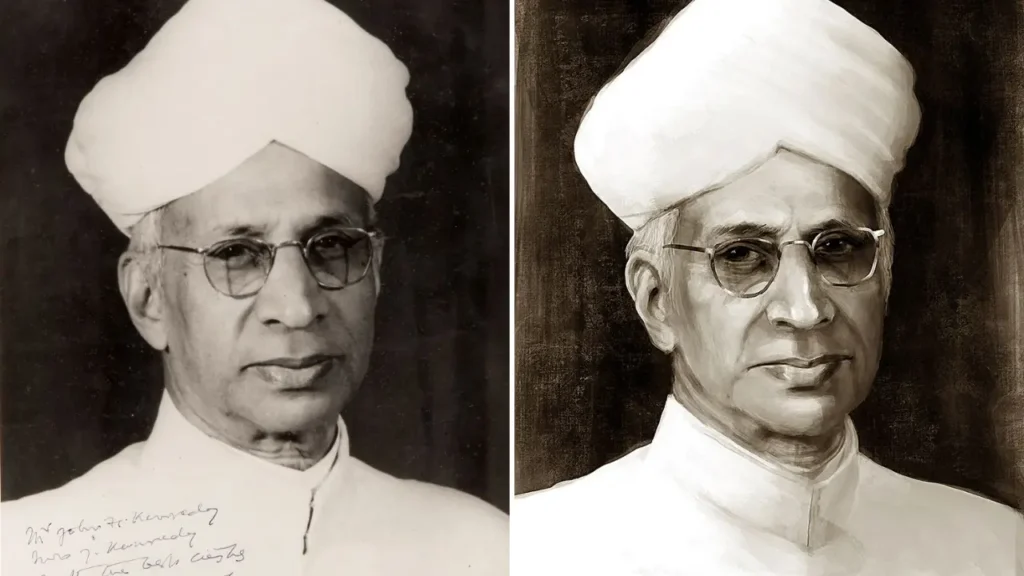EARLY LIFE
Sarvepalli Radhakrishnan was born on September 5, 1888, in the Telugu-speaking Niyogi Brahmin family in Thiruttani, Madras Presidency. His father’s name was Sarvepalli Veeraswami, and his mother’s name was Sarvepalli Seethamma. His early years were spent in Thiruttani, Tirupati.
His father works as a subordinate revenue official for a local Zamindar. His primary education was done at KV High School in Thiruthani. In 1896, he moved to the Hermannsburg Evangelical Lutheran Mission School in Tirupati and the Government High Secondary School in Walajape.
DEATH DATE
Dr. Sarvepalli Radhakrishnan died on April 17, 1975.
EDUCATION
Radhakrishnan was awarded scholarships throughout his academic life. He was admitted to Voorhees College in Vellore but shifted to Madras Christian College at the age of 17. He completed his graduation in 1906 with a Voorha master’s degree in philosophy, being one of its most distinguished alumni.
Radhakrishnan studied philosophy by chance rather than choice. Being a financially constrained student, when a cousin who graduated from the same college passed on his philosophy textbooks to Radhakrishnan, it automatically decided his academic course.
Radhakrishnan Road is the thesis for the MA degree on “The Ethics of the Vedanta and its Metaphysical Presuppositions.” It “was intended to be a reply to the charge that the Vedanta system had no room for ethics.”
When he was 20 years old, his first thesis, “The Challenge of Christian Critics, impelled me to make a study of Hinduism and find out what is living and what is dead in it,” was published. My pride as a Hindu, roused by the enterprise of Swami Vivekananda, was deeply hurt by the treatment accorded to Hinduism in missionary institutions.”.
This led him to study Indian philosophy and religion very deeply and to a lifelong defense of Hinduism against “uninformed Western criticism.”

Also read :- Mahatma Gandhi biography (1869–1948)
ACADEMIC CAREER
When Radhakrishnan was 16 years old, he was married to Sivakamu, who was his distant cousin. And their marriage was fixed by their family as per the customs of that time. After that, they both had six children, of whom five were girls and one was a son. His name was Sarvepalli Gopal. Sarvepalli Gopal became a great historian in his career. Radhakrishnan’s wife, Sivakamu, died in 1956 after 51 years of marriage.
In April 1909, Sarvepalli Radhakrishnan was appointed to the Department of Philosophy at the Madras Presidency College. Thereafter, in 1918, he was selected by the University of Mysore as a Professor of Philosophy, where he taught at Maharaja’s College, Mysore. He believed Tagore’s philosophy to be the “genuine manifestation of the Indian spirit.” In 1920, his second book, “The Reign of Religion in Contemporary Philosophy,” was published.
In 1921, he was appointed at the University of Calcutta as a professor of philosophy and model science. He was represented by the University of Kolkata. At the Congress of Universities of the British Empire in June 1926 and the International Congress of Philosophy at His Word University in September 1926.
In 1929, Radhakrishnan was invited to Harris Manchester College by Principal J. Estlin Carpenter to take the vacant post. This allowed him to teach students at Oxford University about comparative religion. For his education services, he was knighted by George V in June 1931. After the independence of India, he started using the title of doctor before his name.
He remained the vice chancellor of Andhra University from 1931 to 1936. Again, in 1937, he was nominated for the Nobel Prize in Literature, although his nomination process, as for all laureates, was not public at the time. In 1939, he was succeeded as the vice chancellor of Banaras Hindu University by Pt. Madan Mohan Malaviya. He served as its vice-chancellor until January 1948.
POLITICS
Radhakrishnan studied his political career “rather late in life” after his successful academic career. His international authority preceded his political career.







1 thought on “Dr. Sarvepalli Radhakrishnan’s biography ”